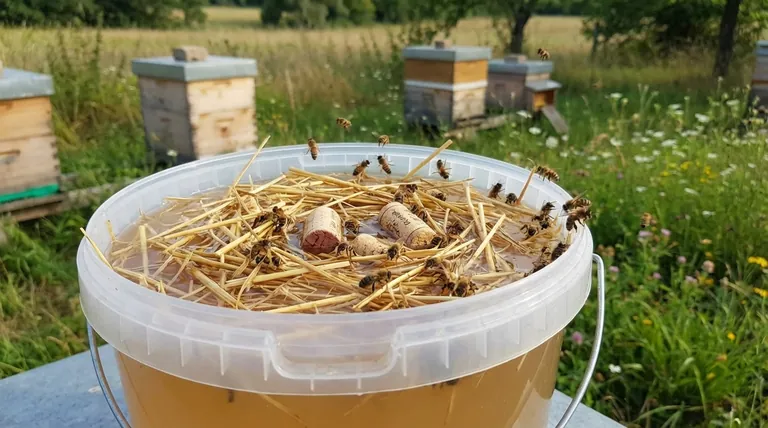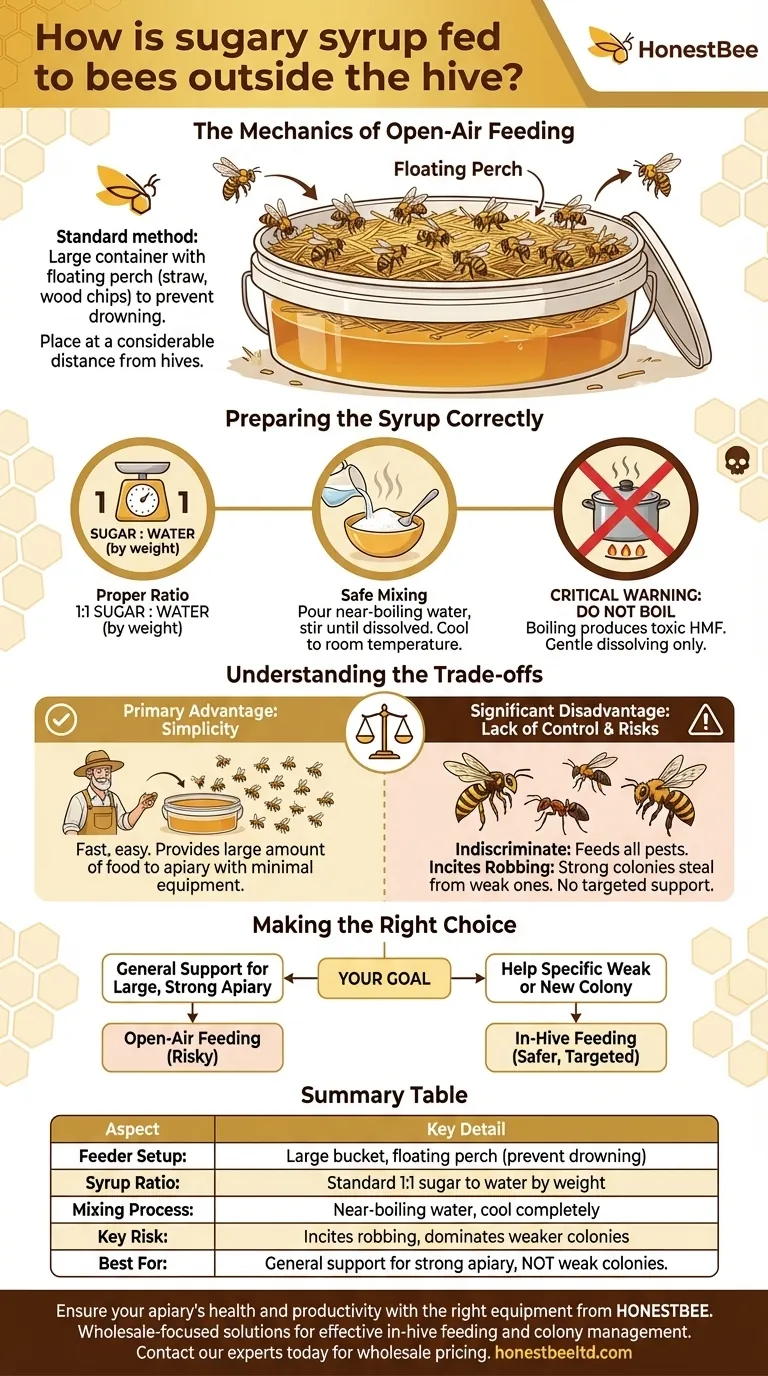To feed bees sugary syrup outside the hive, the standard method involves using a large, open container like a 5-gallon bucket. This bucket is filled with syrup, and a floating perch is added to the surface. This crucial addition allows bees to land and drink without falling in and drowning.
The core challenge of feeding bees isn't just providing sugar, but doing so safely and effectively. While open-air feeding is simple to set up, it introduces significant risks that often make in-hive feeding a more responsible choice for targeted support.

The Mechanics of Open-Air Feeding
Setting Up the Feeder
The physical setup for open-air feeding is straightforward. You need a large, shallow container or a deep bucket.
A floating perch is the most critical component. This can be as simple as a thick layer of straw, wood chips, or even a collection of wine corks spread across the syrup's surface. The goal is to create a platform that prevents bees from making direct contact with the liquid body of the syrup.
Placement Considerations
Place the feeder a considerable distance from your hives. This helps minimize the chances of creating a frenzy right at the hive entrances, which can lead to defensive behavior and robbing.
Preparing the Syrup Correctly
The Proper Ratio
For general feeding, a 1:1 ratio of sugar to water by weight is standard. This mixture provides easily accessible energy for the bees.
The Safe Mixing Process
Pour near-boiling water over the sugar. It is essential that you stir until every crystal is completely dissolved, resulting in a clear, light straw-colored liquid.
Allow the syrup to cool to room temperature before making it available to the bees. Feeding them hot syrup can be harmful.
A Critical Warning: Do Not Boil
Never boil the sugar and water mixture. Boiling can produce a compound called Hydroxymethylfurfural (HMF), which is toxic to bees. Gentle dissolving with hot water is sufficient and safe.
Understanding the Trade-offs of Open Feeding
The Primary Advantage: Simplicity
Open-air feeding is fast and easy. It allows you to provide a large amount of food to an entire apiary with minimal equipment and disturbance to individual hives.
The Significant Disadvantage: Lack of Control
This method is indiscriminate. You are not just feeding your bees; you are feeding every bee, wasp, and ant in the area.
The Dangers of Robbing
Open feeding can incite robbing behavior. Stronger colonies may follow weaker bees back to their hive and attempt to steal their resources. This can quickly decimate a struggling or smaller colony.
Furthermore, it does not guarantee that the specific colony you intend to help is getting the resources it needs. Stronger hives will often dominate the feeder, out-competing the weaker ones.
Making the Right Choice for Your Goal
When deciding how to feed your bees, your specific objective is the most important factor.
- If your primary focus is providing general support to a large, strong apiary: Open-air feeding can be a viable, though risky, method for broad supplementation.
- If your primary focus is helping a specific weak or new colony: In-hive feeding is the superior and safer choice to ensure the intended hive receives the food without competition.
Choosing the right feeding strategy is a key part of responsible and effective beekeeping.
Summary Table:
| Aspect | Key Detail |
|---|---|
| Feeder Setup | Large bucket with a floating perch (straw, wood chips) to prevent drowning. |
| Syrup Ratio | Standard 1:1 ratio of sugar to water by weight. |
| Mixing Process | Use near-boiling water, stir until dissolved, and cool completely. |
| Key Risk | Can incite robbing behavior from stronger colonies and other pests. |
| Best For | General support for a large, strong apiary; not for weak colonies. |
Ensure your apiary's health and productivity with the right equipment from HONESTBEE. Whether you are a commercial apiary or a beekeeping equipment distributor, our wholesale-focused operations provide the durable, reliable supplies you need for effective in-hive feeding and colony management. Let's discuss how we can support your business—contact our experts today for wholesale pricing and product information!
Visual Guide

Related Products
- HONESTBEE Round Hive Top Bee Feeder for Syrup
- HONESTBEE Professional Hive Top Bee Feeder Feeding Solution
- Rapid Bee Feeder White Plastic 2L Round Top Feeder for 8 or 10-Frame Bee Hives
- HONESTBEE Entrance Bee Feeder Professional Hive Nutrition Solution for Beekeeping
- Professional Hive Top Bee Feeder for Beekeeping
People Also Ask
- What types of hive boxes is the round hive top feeder compatible with? Universal Fit for 8 & 10-Frame Langstroth Hives
- How do you set up and use a top feeder for bees? A Step-by-Step Guide for Safe Feeding
- What safety features are included in top feeders? A Guide to Drowning Prevention and Hive Safety
- What can the round hive top feeder be used for? A Guide to Efficient, Safe Bee Feeding
- How should syrup for bees be prepared? Master the Ratio for a Thriving Hive



















